On the occasion of the opening of the academic year 2015, the Central Bureau of Statistics publishes selected data regarding higher education in Israel for the previous academic year 16/XNUMX.
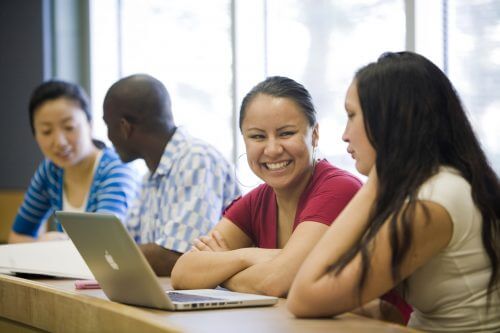
- In the year XNUMX The trend of increasing the number of students has resumed, after it was discontinued in 2014/15. In 3.6, XNUMX thousand students were added, thanks to the increase in the number of students The Arabs (3.2 thousand) fThe Haredim (0.8 thousand). Many resources have been invested in order to increase the number of learners in these populations. It should be noted that the number of other students (non-Orthodox Jews, others) decreased (0.4 thousand).
- In the year XNUMX there were 63 higher education institutions in which 314.4 thousand students studied (of which 46.2 thousand are in the Open University).
- Compared to 2014/15 (0.8/XNUMX), there was an increase (of XNUMX%) in XNUMX in the number of undergraduate students (in universities - a decrease of 2.8% and in academic colleges an increase of 4.3%), an increase of 3.6% in the number of students for a master's degree (in universities, their number decreased by 0.2%) as well as an increase of 0.5% in the number of students for a third degree (universities only).
- In universities, the decline continued In the total number of students, a decrease of 1.7% (1.0% in the previous year). The decrease in the number of bachelor's degree students strengthened (2.8% this year compared to 2.0% in the previous year) and there was a decrease in the number of master's degree students (0.2%).
- In 60, about XNUMX% of the new undergraduate students studied social sciences or humanities, about 70% of the master's degree students studied social sciences or humanities (37.6% and 31.2%, respectively), and the PhD students mainly studied Natural Sciences and Mathematics (40.3%) and the humanities (24.8%).
- in this year, Women made up the majority (58.6%) of all degrees. The proportion of women among the Arabs was particularly high - 67.9%.
- In recent years my rates have increased The Arab students Significantly in all degrees: in the first degree - from 9.8% in 1999 (2000/14.3) to 3.6% in 11.7, in the second degree - from 2.8% to 6.0%, respectively and in the third degree - from XNUMX% to XNUMX%, respectively.
- In 9.9, XNUMX thousand studied for a bachelor's degree ultra-orthodox students, an increase of 8.8% compared to the previous year. They studied mainly subjects from the field of education and training for teaching (28.5%) and only 32.5% were men.
- This year, 20.8% of undergraduate students were from localities in socio-economic clusters high (10-8 clusters). Among master's degree students their rate was 28.6% and for third degree students 33.5%. The rates of students from communities in low socio-economic clusters (clusters 3-1) were 14.4% in the first degree, 10.3% in the second degree and 4.3% in the third degree.
In the last decade, there was a continuous increase in the number of students until the year 2014/15 when the trend stopped (a decrease of 0.1 thousand). In 2015/16 (3.6/3.2) the trend of immigration resumed and 0.8 thousand students were added, thanks to the increase in the number of Arab students (0.4 thousand) and ultra-Orthodox students (XNUMX thousand). In these two populations, many resources were invested in order to increase the number of learners. It should be noted that the number of Jewish (non-Orthodox) and other students decreased (XNUMX thousand).
During the last two decades, higher education in Israel is in a general process of expansion. In 1989/90, there were 21 institutions in Israel that awarded academic degrees, in which 88.5 thousand students studied (including about 13.0 thousand students who studied at the Open University). In 2015/16, there were 63 institutions and 314.4 students studied there (including 46.2 students who studied at the Open University). During this period, the student population grew by 5.0% on average per year. This increase is mainly due to the opening of academic colleges during the 90s and the first decade of the 2000s.
Among the 268.2 thousand students who studied in the year 2015/16 in universities, academic colleges and academic colleges of education, 73.6% (197.4 thousand) studied for a bachelor's degree, 21.7% (58.3 thousand) studied for a master's degree, 4.1% (11.0 thousand) Study towards a PhD and the rest study towards an academic certificate (such as a teaching certificate, a certificate in translation).
The number of undergraduate students increased by 1,500, however, the number of new undergraduate students[1] increased by only 477, so the increase in the number of undergraduate students mainly reflects an increase in the number of veteran students.
the number of students[2] (including the Open University) for a bachelor's degree increased by 0.3%, for a master's degree increased by 3.1%, for a third degree increased by 0.5% and for certificates increased by 2.5%.
In the universities, there was a decrease in the number of undergraduate students (2.8%) - from 80.8 thousand in 2014/15 to 78.6 thousand in 2015/16. An examination of new bachelor's degree students indicates that in the universities the decrease was significant (a decrease of 5.1%) while in the academic colleges their number increased by 7.4% (a 9.7% increase in the budgeted academic colleges and a 4.4% increase in the non-budgeted academic colleges) in contrast to the academic colleges of education ( a decrease of 2.9%). The number of students at Bar-Ilan University decreased by approximately 2.1 students (in the Western Galilee Academic College and the Kinneret Academic College in the Jordan Valley it increased by approximately 650 and approximately 350, respectively). In Ono Academic College, the number of students increased by approximately 2,300.
Most of the decrease in the number of undergraduate students in the universities originates from Bar-Ilan University (86%) and Ben-Gurion University (12%), since fewer students attended colleges under the academic sponsorship of Bar-Ilan University[3] and Ben-Gurion and more studied directly in the colleges.
In 2015/16 (3.6/11.2) there was a 14.1% increase in the number of master's degree students compared to the previous year. This increase is mainly due to the significant increases in the number of students in the academic colleges and the academic colleges of education (0.2% and XNUMX%, respectively). In contrast, the number of students studying for a master's degree in universities decreased by XNUMX%.
It is interesting to see that in 2009/10 the relative share of master's degree students among all students was 19.4%, while in 2015/16, six years later, their relative share rose to 21.7%. The relative share of undergraduate students decreased during this period from 75.8% to 73.6%, respectively.
During the 6 years between 2009/10 and 2015/16, the number of master's degree students in the academic colleges increased by 58%. During these years, the number of master's degree students in the academic colleges of education increased approximately 3.1 times.
In 46.2, 42.7 thousand students studied in the academic track at the Open University, of which 2.0 thousand studied for a bachelor's degree and the rest studied for a master's degree or an academic certificate. In the number of students at the Open University, there was a decrease in the first degree (6.0%) and second degree (6.5%) and an increase in certificate studies (XNUMX%).
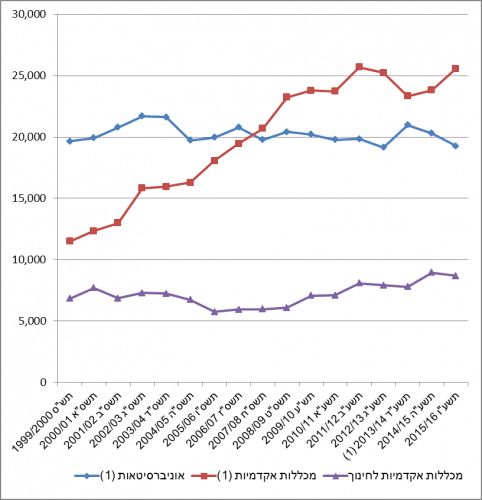

Students by fields of study
In 29.0, the most common fields of study among undergraduate students were social sciences (26.8%) and humanities 30.8%. Similarly, the most common fields of study among new undergraduate students were social sciences (29.1%) and humanities (1999%). For comparison, in the 2000s (35.5/23.8) the proportion of the new bachelor's degree students in the humanities was higher - over a third of the new bachelor's degree students studied this field (37.6%) and about another quarter studied the social sciences (21.2%). In 31.2, the most common field among master's degree students was social sciences (XNUMX%, of which XNUMX% studied business and management) and humanities (XNUMX%).[4] Among the PhD students, 40.3% studied natural sciences and mathematics, and a quarter of the PhD students studied humanities (24.8%).
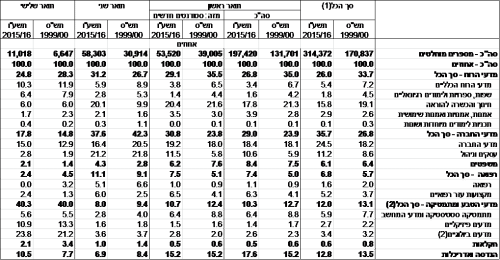
Students by population group
Among the 268.2 thousand students who studied in the academic institutions in 2015/16, 14.3% were Arabs (37.8 thousand students). The relative share of Arabs was greater among students studying for a bachelor's degree or an academic certificate (15.5% and 21.0%, respectively), than among graduate students (11.7% in a master's degree, and 6.0% in a PhD).
Over the past few years, the percentage of Arabs among all students has increased significantly from 9.8% in 1999/2000 to 14.3% in 2015/16. During this period, the rates of Arabs increased significantly in all academic degrees, especially in the second degree (from 3.6% to 11.7%, respectively) and the third degree (from 2.8% to 6.0%, respectively).
Most (88%) of the increase in the number of Arab students in 68 (compared to 20) originates from the increase in the number of Arab students for first (2.65%) and second (XNUMX%) degrees in academic colleges. In the academic colleges, an extraordinary increase (XNUMX times) was recorded in the number of Arab students for master's degrees in the field of business and management sciences.
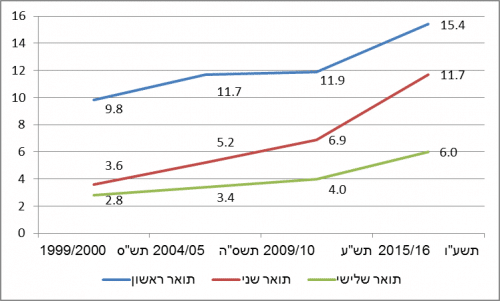
Students by gender
58.6% of the students who studied in the year 2015/16 in the academic institutions in Israel were women, and they made up the majority of all degrees: 57.9% of those studying for a bachelor's degree, 61.9% of those studying for a master's degree, 52.6% of those studying for a third degree and 76.6% of those studying Towards an academic certificate.
In 1999/2000, the majority of Arab undergraduate students were women (61.7%) and in 2015/16, the percentage increased considerably and reached more than two thirds (67.3%), meaning two female students for every male student. In these years, the most significant increases in the proportion of women among the Arabs were in the advanced degrees (in the second degree - from 40.9% in 70.7 to 18.3% in 57.5, and in the third degree - from XNUMX% to XNUMX%, respectively). During this period, there were no significant trends in the number of women among Jewish and other students, but they constituted a majority in all degrees.
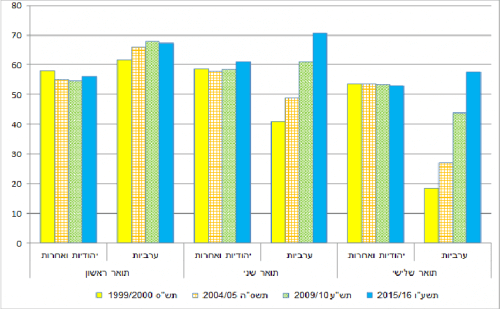
ultra-orthodox students[5]
In 2015/16, 9.9 thousand ultra-orthodox students studied for a bachelor's degree, including at the Open University, compared to 9.1 thousand in 2014/15. In 2015/16, 6.5 thousand of the students were women (66.5%).
1.3 thousand ultra-Orthodox students studied at universities, 1.3 thousand - at the Open University, 4.6 thousand - at academic colleges and 2.6 thousand studied at academic colleges for education.
The ultra-orthodox students (men and women in total) focused mainly on studies in the field of education and teaching training (28.5%), in the field of social sciences (17.2%) as well as business and management sciences (12.2%).
The ultra-orthodox female students focused mainly on studies in the field of education and training for teaching (31.9%), in the field of social sciences (16.1%) as well as business and management sciences (13.4%) and auxiliary medical professions (13.3%).
The male ultra-orthodox students focused mainly on studies in the field of education and teaching training (21.8%), in the field of social sciences (19.4%) and law (18.3%).
Students[6] According to socio-economic cluster of residential settlement[7]
In the year 2015/16, 20.8% of undergraduate students were from communities in high socio-economic clusters (clusters 10-8). Among master's degree students their rate was 28.6% and for third degree students 33.5%. In 2014/15, the rates were 20.8%, 28.8% and 33.7%, respectively. The rates of students from communities in low socio-economic clusters (clusters 3-1) were: 14.4% in the first degree, 10.3% in the second degree and 4.3% in the third degree. In 2014/15, the rates were 13.6%, 9.6% and 4.4%, respectively.
Comments
[1] New student: A student studying for the first time in the higher education system.
[2] including the Open University. The rest of the data in this announcement do not include the Open University, except where this is explicitly stated. The Open University has characteristics that set it apart from other higher education institutions. This is reflected in open admission for bachelor's degree studies (without prerequisites), in the flexibility in choosing the individual course of study and the duration of the studies. However, the ambition is to integrate the data of the Open University into the current statistics of the higher education institutions, while referring to its uniqueness.
[3] Ashkelon Academic College; Kinneret Academic College in the Jordan Valley; Safed Academic College; Western Galilee Academic College;
[4] The subjects of education and training for teaching are included in the field of humanities. The rate of those studying these subjects among all master's degree students increased from 9.9% in 1999/2000 to 19.2% in 2015/16.
[5] An ultra-orthodox student is one whose last school he attended was under ultra-orthodox supervision.
[6] Not including the Open University.
[7] According to the socio-economic index for 2008. The information on the student settlements refers to January 2014. In the calculation of the socio-economic index, a methodological change was made relative to last year. For an explanation of the socio-economic index, see definitions and explanations below.

2 תגובות
Interesting article. More students, less study in difficult universities.